ACTIVITY
Girls, do Physics!
WINNERS
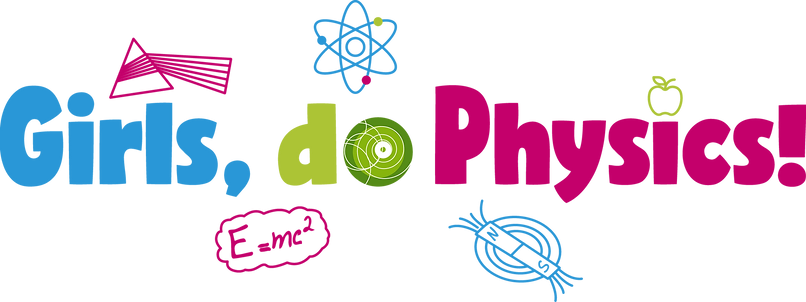
First Prize
#girlsdophysics + #girlsdoparticlephysics
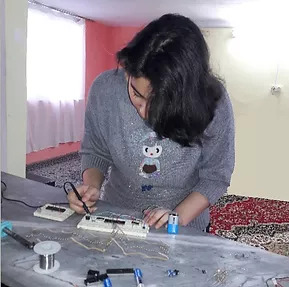
Sara Heidari
18 years old, Iran
Sara made an experiment with LEDs applying the Ohm’s law: (V/I=R)
She built an electronic board with a photocell, a battery, some resistors, LED lights and a switch. When the ambient light increases, the photocell detects and collects it. The current generated causes the resistance to decrease, so the LED turns off. The contrary happens when ambient light decreases. This technique allows automatic switching of lights, resulting in a lower consume of electricity.
Sara says: “I believe in equal rights and opportunities for men and women. Participating in the campaign Girls Do Physics! helped me to become confident in myself and my abilities, to try and show them to people and prove that girls can do everything!”
Second Prize
#girlsdophysics + #girlsdoparticlephysics
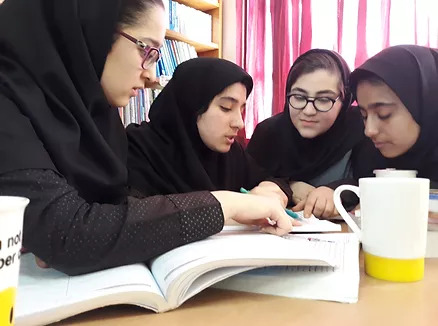
Aniseh Yarabi, Ayda Taji, Nazanin Rezayi, Soheila Maaghool, Hanie Sarayani
17-18 years old, Iran
Team coach: Seddigheh Rezapour
This group of students from the Al-Mahdi High School in Iran, under the guidance of their professor, studied the feasibility of the Young experiment (which is related to the photon) with subatomic and fundamental particles. They made calculations on lifetime, decay and momentum of various particles (kaons, pions, positrons and protons).
They say: “By studying physics and making experiments, we develop the skills necessary for being part of the future of science and research. While working on this project, we realised how teamwork and the use of collective wisdom is important to achieve a result. We profited of the abilities of each of us in different fields, such as mathematical computing skills, quick understanding of concepts and ability to transfer them to others, photography experience, etc. We also became acquainted with the basic concepts of particle physics and we understood that physics plays a relevant role in today’s technology and it will do so even more in the future. Its applications, such as hadrontherapy among the others, fascinated and encouraged us to study and continue our college education up to completing a Ph.D.
We think that the future of science and a good job in this field is waiting for us.”
Third Prize
#girlsdophysics
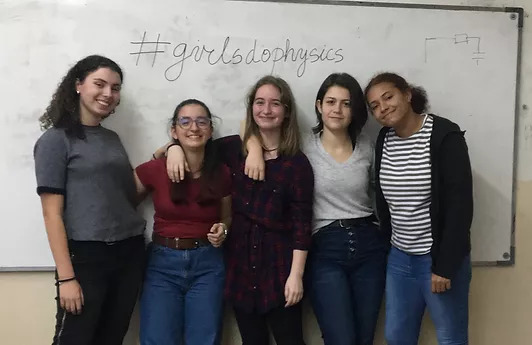
Daniela Ivailova Nikolova, Tina Miroslavova Garnenkova, Irina Georgieva Georgieva, Iva Rusinova Atanasova, Stela Rusinova Atanasova, Stela Delqmova Mihova, Ivana Georgieva Hristova
15-17 years old, Bulgaria
Physics club headed by Elena Karamcheva
This team of young students from the English Language Middle School “Geo Milev”, in Burgas (Bulgaria), made an experiment putting pepper grains and water in a shallow dish, adding some soap to it and observing what happened.
“We understood that by putting soap in the water, we break down the surface tension of the liquid," they explain. "This is one of the reasons why soap makes a good cleaner. When soap is added, the surface tension is reduced, and the water wants to spread out flat. As it spreads out, it carries away with it the pepper floating on its surface.”
They add: “We like extracurricular science activities, we are even members of a physics club. We are making interesting experiments, to understand the laws of nature.”
Fourth Prize
#girlsdophysics
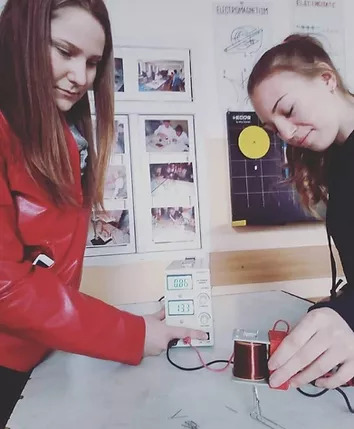
Georgiana Stancu, Raisa Rogozan
16 years old, Romania
Teacher: Ellen Popovici
Guided by their Physics teacher, Ellen Popovici, Georgiana and Raisa carried out an experiment on electricity and magnetic field. When electricity flows through a conductor, a magnetic field is generated around it. In order to prove it, they charged a coil with a low-tension source (continuous flow of electricity) and they noticed that the coil attracted the clippers (which were made of iron). Thus, they pointed out that the coil, when electricity passes through it, behaves like a magnet.
They say: “The physics of today will be the technology of tomorrow.”
Special Prize: Most Active Participant
#girlsdophysics
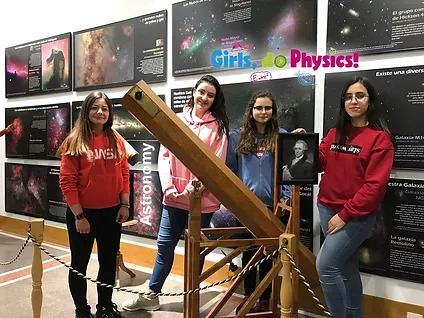
Elvira Contreras Martos, Tania Fernández Milán, Carla Martínez Alcaraz, Lucía Garrido Martínez
15 years old, Spain
Team coach: José María Díaz Fuentes
Together with their professor of Physics and Chemistry, José María Díaz Fuentes, this team of young girls studying at the "Santo Domingo Savio" School in Úbeda (Spain) developed a number of experiments on electricity, radioactivity, astronomy and particle physics.
Elvira says: “Physics is the only way we have to understand how the Universe works, is there anything more impressive than that? When you study physics, you study the world itself. It’s amazing! For so many years I have been listening to teachers, familiars or even friends talking about it, and their motivation was so inspiring that I started to feel keen on it.
Nowadays, I can say that this is the best thing I have done in my life."
Tania: "I think physics is a very interesting science, I also love astronomy and I want to learn more. Since less than 20% of the scientists are women, I think that we need to involve other women and share our passion with them.
I can't imagine what would it be if Einstein, Darwin or even María Asunción Català (a renowned Spanish astronomer) didn't discover those things that made them famous. Physics is amazing!"
Carla: "Last year our teacher explained us the real meaning of physics, so I started to investigate and I am really curious about these studies. You can make many very beautiful experiments, we have only started exploring the world of physics, but we can already see that it is incredible."
Lucia: "When my teacher asked me: 'Why do you like physics?', I didn't know what to answer. Since I was a kid, I was very interested in how things around me can work. From making my own experiments, to guess the operation machines perform. Now, I know that there are more aspects of physics that I would like to study. I'm very proud of all the scientists of the past and especially of the women among them, whose work has opened up the way for us, young girls, to take part in science."
The teacher to her students: "Tania, Carla, Lucia, Elvira, I am enormously proud of you! Honestly, I don’t think and never thought there is any gender difference either in science or in almost any aspect of life. The future is yours and I'll give my love for each step you take!
Physics is the way to connect directly with the Universe and my best wish for you is that you always fall in love with it."
Special Prize: The Youngest Participant
#girlsdophysics
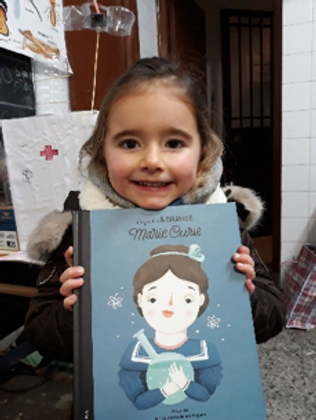
Valle Sainz-Maza Ruiz
4 years old, Spain
Teacher: Bárbara de Aymerich
Valle studies science at the "Escuela de Pequeñ@s Científicos Espiciencia"in Burgos (Spain). She has been attending this school for little scientists for a year and she had been to their summer campus twice. She loves science and is fascinated by stars and inventions.
Her teacher, Bárbara De Aymerich, says: “The picture was taken one day after class at our small science school. Valle was excited because she was given a children's book about her favourite scientist, the incredible Marie Curie. Valle does not know how to read, but she could understand the story by the drawings. She is wonderful, independent, sweet, responsible and methodical. I'm sure she will become a great physicist."
Valle says: "It doesn't matter that I am still little, I am going to study science and help others."




